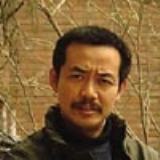
Sui Jianguo
Encyclopedia

Beijing
Beijing , also known as Peking , is the capital of the People's Republic of China and one of the most populous cities in the world, with a population of 19,612,368 as of 2010. The city is the country's political, cultural, and educational center, and home to the headquarters for most of China's...
, is a contemporary Chinese
People's Republic of China
China , officially the People's Republic of China , is the most populous country in the world, with over 1.3 billion citizens. Located in East Asia, the country covers approximately 9.6 million square kilometres...
art
Art
Art is the product or process of deliberately arranging items in a way that influences and affects one or more of the senses, emotions, and intellect....
ist.
Sui was born in an ordinary workers' family where none of his parents had ever been in school. Before his formal education in Western art, he learned a few years of traditional Chinese painting in his hometown Qingdao. In the mid 80s, he graduated from Shandong Art College with a sculpture major; a few years later, he finished his Master degree of Art in the Central Academy of Fine Arts in Beijing. Then he took the faculty position in the department of sculpture, started his teaching and his own studio works in Beijing. He also spent some time teaching abroad as guest professor.
Sui has been a very active artist on the stage of modern and contemporary art in China. He had numerous solo and joint exhibitions in Japan, Australia, Hong Kong, India, Taiwan, and most recently in the United States, in addition to his active schedules in China, and several high-profile exhibitions worldwide. He likes to work with hard and heavy materials such as granite and metals. His techniques of sealing, binding, tying and hammering created a relationship of association and confrontation between his materials, which resonate with his perception of life and his internal conflicts. Among his known works in the early 1990s are ‘Land Depression’ in which Sui entwines huge boulders in nets made from steel ropes, and ‘Sealed Memory’, a closely welded cabinet of thick steel sheets, which gives an oppressive sense of weight and blockage. His work ‘Memory’ is a wall made out of old railroad sleepers. The sleepers have been ground down just as humans ground down by life, and they become part of a dividing wall, a boundary.
Many Sui early works reflect his personal experiences and explore, to a lesser or greater extent, his anxieties and feelings of imprisonment. He began his ‘Mao Suit’ series in 1997. This series can however be regarded as the conclusion of an important stage in his self-exploration. He draws on the powerful image of the Mao suit, not as an element of revolutionary attire but as a symbol of restriction and limitation. Sui suggests that none of the Chinese has truly taken off their Mao suits even though the revolutionary era is over. Sometimes Sui makes the Mao suits resemble Buddhas and at other times he turns them into hard shells. Recently, Sui has made fairly humorous, soft and almost transparent Mao suits. The Mao suit is perhaps coming to represent to the artist an object of fun. Over all, Sui's work has well represented the views and expressions of his generation, the generation that survived Mao's cultural revolution. More importantly, as one of the most active and most productive artists in China today, and as the head of the department in the most prestigious art institute in China, he has also brought fundamental changes to the contemporary art movement in recent China. Because of his influential works and through his educational efforts, abstract and conceptual sculpture have been well accepted by the ordinary Chinese people and by the authorities. Further more, he has taken the rule of bringing the contemporary art of modern China to the world. His works have been well recognized by the Western art world.
Contemporary art in China has been active more than ever, both inside and outside of China. Unlike other negative cultural changes brought about by the economic booming in China, educational and cultural art activities have been growing steadily and healthily, riding along the economical growth. In his most recent work, the red dinosaur – a symbol of imperialist China, like communist China- with the engraved door on the chest mentions ‘Made in China’; it is a glance toward plastic toys from the start of the Chinese economic flight, but definitely a powerful symbol of an antiquated China moving toward being contemporary. Throughout the 1960s, everything was 'Made in Japan', in the 1970s 'Made in Taiwan', and in the 1980s 'Made in China'. The fabrication of finished products based on models and imported raw materials has become the economic norm of emerging countries. This economic international capitalistic model has helped to accelerate stimulating an economic transformation of an archaic and impoverished China. The transplantation of the ‘Consumer Culture’ at such an astronomical scale from the Chinese population has made China the biggest unknown in the world’.
In addition to the highly contemporary and artistic expression and deep and heavy impact, Sui's works often show extraordinary classic and museum quality, which have drawn attentions of many private collectors all over the world for the last twenty years, and more so recently from museums in the West. As some reviewers put, surpassing China's borders, Sui Jianguo is probably one of the most promising sculptures of the 21st century.
External links
- Artnet
- ArtZineChina
- XibArt
- http://www.hdemontferrand.com/artist/works/SUI-JIANGUO/gb-5.htmlSui Jianguo, Hadrien de MontferrandHadrien de MontferrandHadrien de Montferrand The French Ambassador of Drawings is a French specialist in Chinese Contemporary Art. He is one of the actors who helped Chinese Contemporary Art to develop its influence abroad.-Biography:...
Gallery] - BigCrow
- SFGate
- ArtSlant

